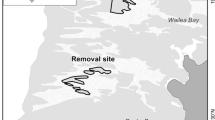Abstract.
Replicated ecological studies in marine reserves and associated unprotected areas are valuable in examining top-down impacts on communities and the ecosystem-level effects of fishing. We carried out experimental studies in two temperate marine reserves to examine these top-down influences on shallow subtidal reef communities in northeastern New Zealand. Both reserves examined are known to support high densities of predators and tethering experiments showed that the chance of predation on the dominant sea urchin, Evechinus chloroticus, within both reserves was approximately 7 times higher relative to outside. Predation was most intense on the smallest size class (30–40 mm) of tethered urchins, the size at which urchins cease to exhibit cryptic behaviour. A high proportion of predation on large urchins could be attributed to the spiny lobster, Jasus edwardsii. Predation on the smaller classes was probably by both lobsters and predatory fish, predominantly the sparid Pagrus auratus. The density of adult Evechinus actively grazing the substratum in the urchin barrens habitat was found to be significantly lower at marine reserve sites (2.2±0.3 m–2) relative to non-reserve sites (5.5±0.4 m–2). There was no difference in the density of cryptic juveniles between reserve and non-reserve sites. Reserve populations were more bimodal, with urchins between 40 and 55 mm occurring at very low numbers. Experimental removal of Evechinus from the urchin barrens habitat over 12 months lead to a change from a crustose coralline algal habitat to a macroalgal dominated habitat. Such macroalgal habitats were found to be more extensive in both reserves, where urchin densities were lower, relative to the adjacent unprotected areas that were dominated by urchin barrens. The patterns observed provide evidence for a top-down role of predators in structuring shallow reef communities in northeastern New Zealand and demonstrate how marine reserves can reverse the indirect effects of fishing and re-establish community-level trophic cascades.
Similar content being viewed by others
Author information
Authors and Affiliations
Corresponding author
Additional information
Electronic Publication
Rights and permissions
About this article
Cite this article
Shears, N.T., Babcock, R.C. Marine reserves demonstrate top-down control of community structure on temperate reefs. Oecologia 132, 131–142 (2002). https://doi.org/10.1007/s00442-002-0920-x
Received:
Accepted:
Published:
Issue Date:
DOI: https://doi.org/10.1007/s00442-002-0920-x




